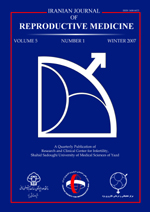
|
International Journal of Reproductive BioMedicine
Research and Clinical Center for Infertility, Shahid Sadoughi University of Medical Sciences of Yazd
ISSN: 1680-6433
EISSN: 1680-6433
Vol. 11, No. 11, 2013, pp. 925-932
|
 Bioline Code: rm13118
Bioline Code: rm13118
Full paper language: English
Document type: Research Article
Document available free of charge
|
|
|
International Journal of Reproductive BioMedicine, Vol. 11, No. 11, 2013, pp. 925-932
| en |
Seminal bacterial contaminations: Probable factor in unexplained recurrent pregnancy loss
Nabi, Ali; Khalili, Mohammad Ali; Halvaei, Iman; Ghasemzadeh, Jalal & Zare, Ehsan
Abstract
Background: It is estimated that about 50% of causes of recurrent pregnancy loss (RPL) cases remain unknown. Sperm factors are suggested to have probable role in cases with RPL.
Objective: The goal was to determine the possible relationship between semen bacterial contaminations with unexplained RPL. Also, the correlation between number of bacterial colony and sperm chromatin condensation was examined.
Materials and Methods: This study consisted of 30 fertile men (group A) and 30 infertile (group B) men with unknown RPL. Semen collection and analysis were done according to WHO manuals. Sperm count and motility were evaluated by Makler chamber. Eosin-Nigrosin and Papanicolaou staining methods were applied for viability and morphology assessment, respectively. The semen samples from both groups were cultured for aerobic bacteria. Aniline blue (AB) and toluidine blue (TB) staining methods were applied for evaluating sperm chromatin condensation.
Results: The numbers of colonies were significantly higher in group B when compared to group A. Also, S. aureus and E. coli contaminations showed significant differences between two groups. Both AB+ and TB+ sperm cells showed significant increase in group B compared to group A. There was a significant negative correlation between colony number and progressive motility (p=0.01), and sperm viability (p=0.007). In addition, positive correlations were found between colony number and AB+ (p=0.001) and TB+ (p=0.004) as well.
Conclusion: Bacterial contaminations in semen of men from RPL couples had significantly higher levels when compared to fertile controls. Presence of microorganisms in semen may be correlated with irregular sperm parameters and quality.
Keywords
Recurrent pregnancy loss; Bacteria; Semen
|
| |
© Iranian Journal of Reproductive Medicine
Alternative site location: http://www.ijrm.ir
|
|
